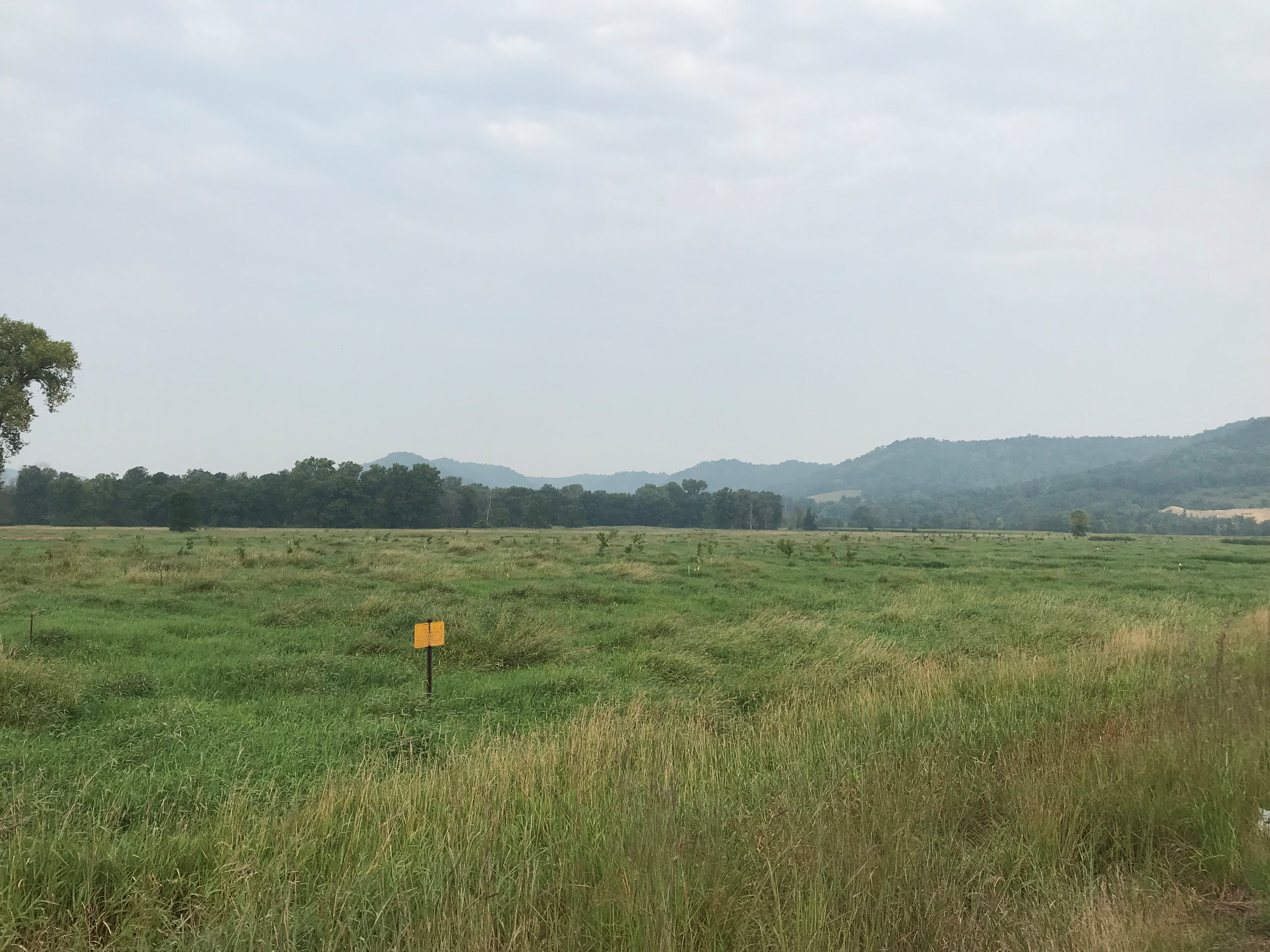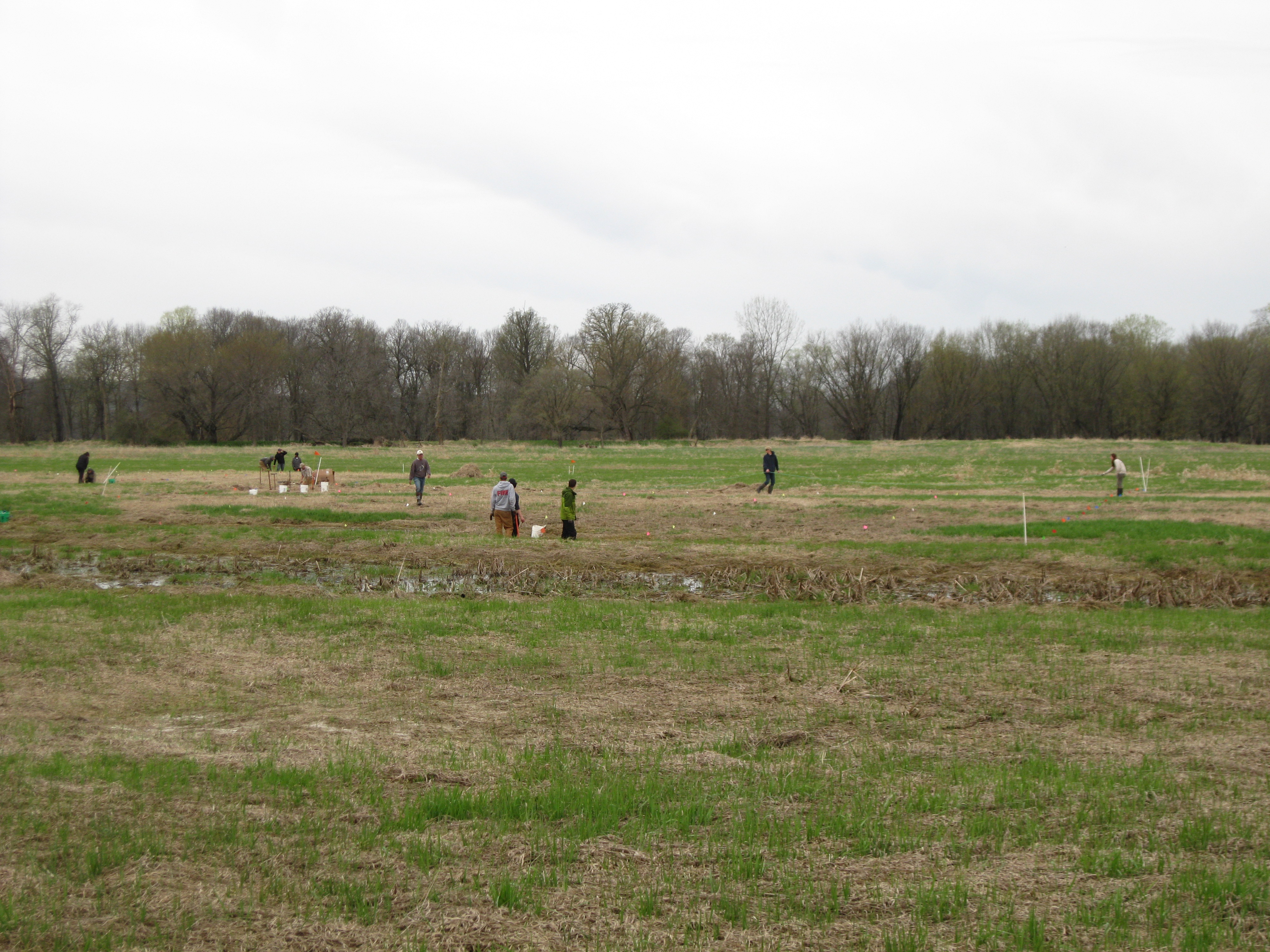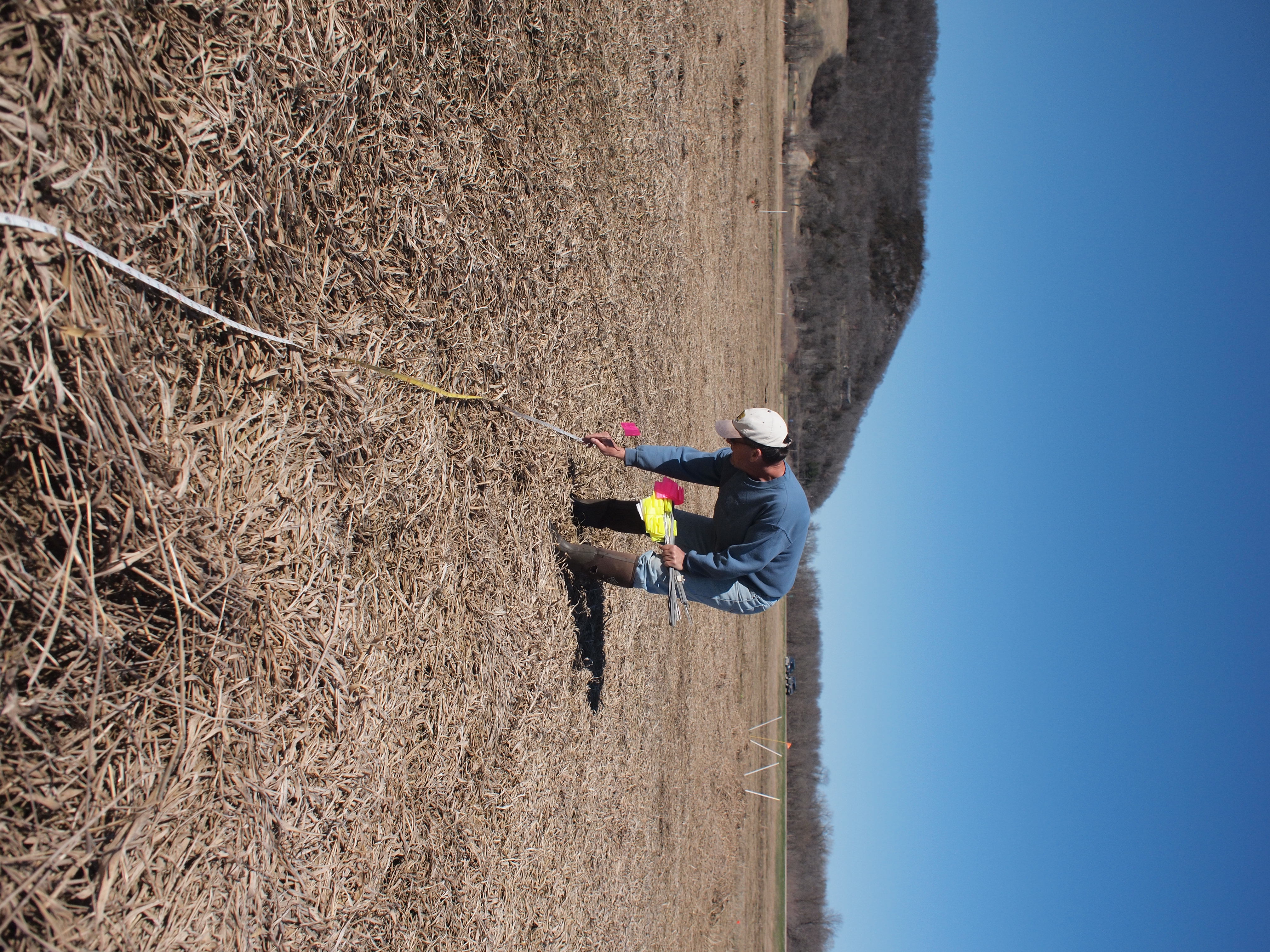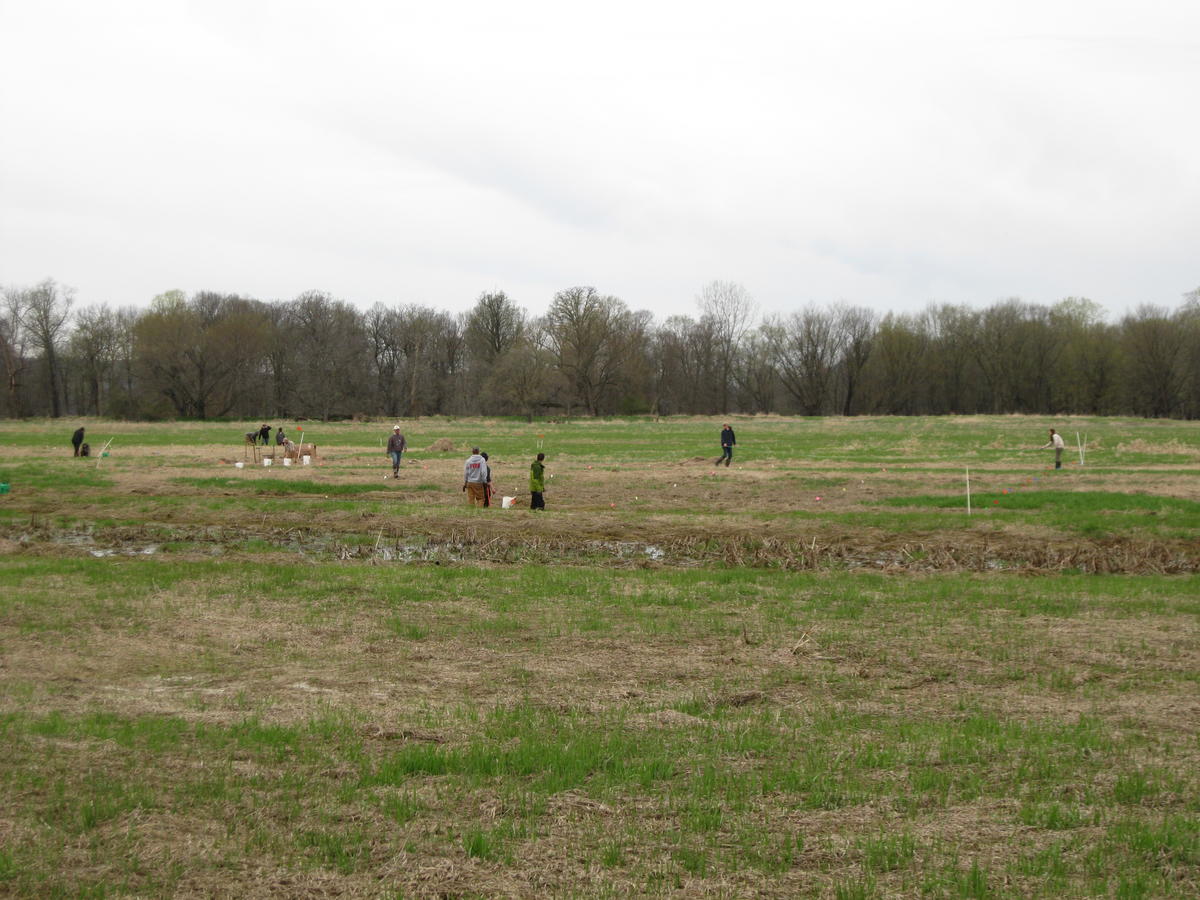Overview
This case study was designed to evaluate the effectiveness of two different herbicidal regimes (oust with tillage versus Rodeo without tillage) and three different planting stock types (2 gallon containerized, bare root, direct seeding) within reed canary grass dominated lowland sites.
Reed canary grass is the most pervasive pest in bottomland forests and wetlands throughout Minnesota and Wisconsin. Hatch and Bernthal (2008) found that approximately 500,000 wetland acres are infested with reed canary grass in Wisconsin alone. Reed canary grass greatly reduces diversity in flora and fauna alike leading to less resilient habitats. Dense colonies of the grass can constrict waterways, greatly impact infiltration and consequently impact the denitrification process leading to further downstream impacts. Reed canary grass poses a major competitive threat to tree plantings, forms dense monocultures that prevent natural regeneration from occurring, and all too often presents land managers with very few restoration options.
Bottomland hardwood stand data:
River: Root River
River type: Minor river
Floodplain topographic position: Bottom (not terrace)

Figure 1: Site from a distance
Pre-treatment stand description and condition
Stand establishment and management history:
The site was historically in an area characterized by wet meadow (grasses and forbs). The site has been hayed and possibly grazed until its acquisition in 1989. The site was previously part of a wet meadow restoration trial which attempted to establish greater native cover on the site through mechanical and chemical means, albeit unsuccessful.
In the fall of 2016 the site was prepared by a combination of herbicide treatment and mowing. In the Spring of 2017 the site was planted with 2 gallon containerized (RPM) trees and bare root stock. RPM trees were planted at a density of 60 TPA across 8 acres while bare root trees were planted at a density of 356 TPA across 8 acres.

Figure 2: Planting Bare Root Trees
Pre-treatment forest health issues:
Reed canary grass and high water levels were and remain to be the greatest forest health threats to this site. Prior to treatment the site was not characterized as forested and was instead more characteristic of an abandoned reed canary grass hay field.
Landowner objectives/situation:
The objectives for this site were twofold:
First and foremost the objective here was to establish native trees on the site in an effort to bolster diversity. Native trees additionally present to potential to shade out reed canary grass thus providing growing space for more desirable species.
The second objective here was to evaluate the effectiveness and success of multiple herbicides, mechanical techniques, and plant stock types. Through this evaluation the intent was to better understand the most cost effective methods of weed control and reforestation.
Silviculture Prescription
This case study refers to one of four sites that encompassed a larger reforestation research project. The goal of the project was to evaluate different planting methods and herbicidal regimes. Bare root trees and containerized (RPM) trees were planted while the herbicides Oust and Rodeo were compared for effectiveness.
This particular site was divided in to 8 acres of treatments and 2 acres of control. Of the 8 treatment acres, ½ of the sites were treated with Rodeo and ½ of the sites were treated via forestry mulcher and Oust. The herbicide regime is detailed below
Fall 2016
All chemically treated sites were sprayed using a Polaris ranger with a 75 gallon bloomless sprayer
(4 acres RODEO): In late October 2016 the sites were chemically treated with Rodeo at a rate of 2 quarts/ac and MSO at a rate of 2.8 ounces/acre. The sites were treated late enough in the season that reed canary grass was the only actively growing vegetation on the site. Although grass was thick and mature, it had fallen over “flopped” adequately and relatively even application was deemed possible.
(4 acres OUST): In August of 2016 a forestry mulching head attached to a small skid steer was used to mechanically mow the site. The original intent of this project was to expose reed canary grass rhizomes by tilling into the upper soil. In practice it was only possible to mow the grass as the mulching head could not penetrate the soil surface. In late October 2016 the sites were chemically treated with Oust at a rate of 1 ounce/ac and MSO at a rate of 2.8 ounces/acre. The sites were treated late enough in the season that reed canary grass was the only actively growing vegetation on the site. Although grass was thick and mature, it had fallen over “flopped” adequately and relatively even application was deemed possible.
Spring 2017
Trees were planted in the spring of 2017 across the 8 acres of treatment. Trees were planted at a rate of 60 TPA (RPM) and 356 TPA bare root. All planting was conducted by hand and thorough quality assurance was preformed to ensure trees were properly handled and planted. Planting conditions were superb with high humidity and overcast skies. RPM trees were fitted with a tree tube (24" vole gaurd) and a tree stake for support.
Fall 2017
The Prescription here intended to re-treat the plantings with the same herbicide regimes following the first growing season. Reed canary grass was to be chemically treated in the fall after a hard frost. Frost conditions typically lead to tree defoliation and dormancy while reed canary grass is still actively growing and susceptible to herbicide
What actually happened during the treatment
The treatment went as intended until the fall of 2017. Planted trees held onto green leaves late into the growing season thus chemical treatment was deferred until the following spring. The following spring was far too wet to access the sites, so a grass specific herbicide was planned to be used as early as the sites were accessible. High water remained an issue late into the application season and grass specifics were deemed to no longer be an effective alternative. Mowing was attempted in an effort to manage reed canary grass between planted tree rows, however thick reed canary grass overpowered a 12 horse pull behind mower. More late season rain caused sites to be too wet to access in the fall of 2018.
Post-treatment assessment
Two growing seasons following the planting, 73% of the RPMs and 6% of the bare root trees are surviving on the site.
After the intial herbicide treatement a few non RCG species did germinate. Samrtweeds, burnweed, and a few other short lived moist soil unit forbes were found. These species were not present the second growing season following the treatment.
Plans for future treatments
Because only 6% of the bare root stock has survived after 2 years, and because the site has proven to be incredibly difficult to enter, there are no further treatments planed at this time. If the RPM trees continue to survive at or near their current rate, the site may still be able to achieve canopy closure as the trees mature.
Future treatments may be planned when the trees reach sexual maturity and can function as seed trees. Intensive site preparation may be performed in order to prepare a seed bed for natural regeneration. Ideally the trees will eventually cast enough shade onto the site and cause reed canary to preform less vigorously.
Costs and economic considerations
Much of the work was conducted with in house labor and Conservation Corps MN crews, thus cost estimates may not be applicable to every project at a similar site. Herbicide application was only preformed a single time and is calculated as such. The following budget breakdown provides a fairly accurate depiction of the projects fair market value, though a more successful planting would require additional follow up costs.
|
Description/Product |
Price($)/unit |
Quantity |
Total Cost ($) |
|
RPM tree |
12.7 |
480 |
6096 |
|
Bare Root Tree |
0.6 |
2848 |
1708.8 |
|
RPM Tree Stake and Nursery Tape |
1 |
480 |
480 |
|
RPM Tree Tube |
0.93 |
480 |
446.4 |
|
Herbicide treatment |
100 |
8 |
800 |
|
CCM Labor |
1000 |
4 |
4000 |
|
TOTAL |
13531.2
|
Climate Change Considerations
Climate change threatens native plant communities and can complicate restoration efforts on many fronts. Reed canary grass can exacerbate climate change related issues by limiting soil infiltration, nutrient cycling and carbon sequestration.
This prescription does not explicitly address climate change; however it aims to restore a more resilient and diverse plant community where a relative monoculture presently exists.
Summary / lessons learned / additional thoughts
In retrospect, much more site preparation should have been conducted prior to planting. It was wrongly assumed that follow up treatments could be performed to maintain the site, and so certain aspects of the planting were lost to competition. Multiple years of chemical and mechanical site prep should be performed prior to planting in reed canary dominated open filed systems.
The project could have also been more successful if more appropriate wetland equipment were to have been utilized. Using a Marsh Master rather than a 4x4 UTV would have allowed easier access to the site even in adversely wet conditions.
Lastly we were too reliant on being able to spray reed canary grass in the late fall after trees have gone dormant but while reed canary is still actively growing. While late fall is a valid and very effective time to treat reed canary grass, the limited time window proved itself to not always coincide with proper treatment conditons.

Figure 3: Tree Placement Flagging
Literature cited:
Hatch, B.K. and T.W. Bernthal. 2008. Mapping Wisconsin wetlands dominated by reed canary grass, Phalaris arundinacea L.: a landscape level assessment. Wisconsin Department of Natural Resources, PUB-WT-900-2008.
This case study was developed with support from the United States Department of Agriculture's National Institute for Food and Agriculture (USDA-NIFA), Renewable Resources Extension Act (RREA). Project #MIN-44-E02, principal investigator Eli Sagor, University of Minnesota.
